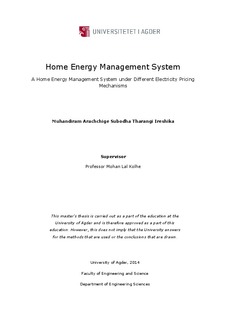| dc.description.abstract | Peak demand is a severe problem in the electricity grid and it was solved by supply side management in the past. But nowadays the demand side management sources have drawn attention due to the economic and environmental constraints. Demand side management in the domestic sector can play an important role in reducing the peak demand on the power system network. It can help in reducing stress and overloading on the transmission and distribution lines. In many countries there are various demand response programs implemented for industrial and commercial loads. In these programs load control is primarily achieved by various types of pricing mechanisms. There are very few demand response programs in use for energy management in residential sector. Direct curtailment of the loads is the most popular method used to reduce the peak demand in the domestic sector. But by direct load control, customer comfort may be compromised. In contrast peak load reduction through load shifting can benefit both consumers and utilities. In order to analyze demand response in the domestic sector, it is important to understand physical based power intensive load models with an emphasis on water heater units, air conditioner units, clothes dryers and electric vehicles. In this work, these load models are developed considering thermodynamic principles of buildings as well as their built in technical parameters. With the development of smart grid systems specially in the distribution network and possibility of load modeling, there is a requirement of a domestic intelligent energy management algorithm. In this work, power intensive non-critical loads are managed through developed energy management system algorithm and these loads are water heater, air conditioning unit, clothes dryer and electric vehicle. With the introduction of electric vehicles, demand responses can be performed within home for avoiding any overloading problems in the distribution network as well as on power generation. Additionally, the electricity bill saving which can be gained through proposed energy management system is analyzed by considering different electricity pricing mechanisms. The highlight of the presented energy management system algorithm for home energy management is its capability to control the non-critical loads below specified peak demand limits by considering consumer behavior and priorities, giving consumers more flexibility in their operational time. Moreover, the results show that the electricity saving which can be gained through the proposed energy management system lies in a noticeably high range. It is expected that the research findings of this work can be beneficial to utilities in providing information of limits and scope of domestic demand responses. And also it is anticipated that the cost analysis carried out can be used to motivate the consumers towards demand response through the developed energy management system. Key words: Domestic demand response, Home energy management system (EMS), demand limits, non-critical loads, load priority, Time of Use pricing, Real Time Pricing | nb_NO |
